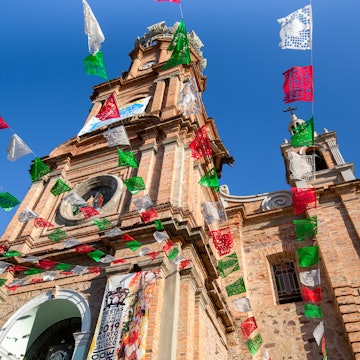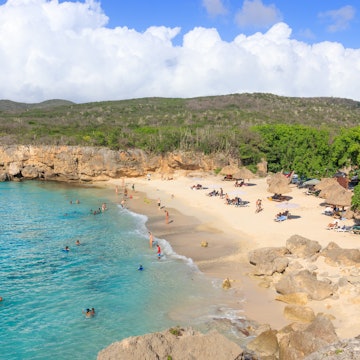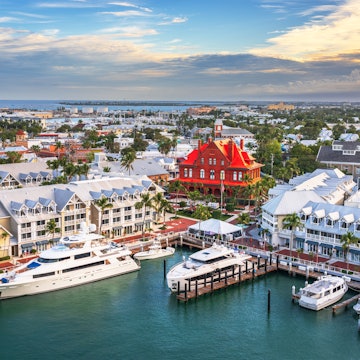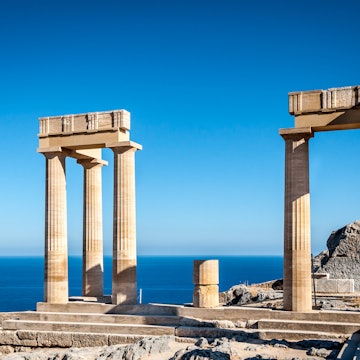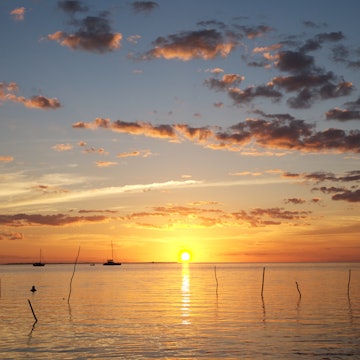
A spiritual journey through Wakayama and Nara Prefectures
Sponsored by
Mar 9, 2021 • 10 min read

Wakayama and Nara Prefectures offer a journey to a lush, misty, mystical part of the world steeped in history and culture © Courtesy of Kinki Transportation Bureau
Deep in the rugged mountain ranges of Wakayama and Nara prefectures, the Sacred Sites and Pilgrimage Routes in the Kii Mountain Range comprise three main areas: Kumano Sanzan, Koyasan, and Yoshino-Omine. Two of these, the majestic temple complex of Koyasan and the sacred mountain of Yoshino, offer a journey to a lush, misty, mystical part of the world steeped in history and culture.
The areas are deeply spiritual, offering the perfect path to anyone seeking to escape the stresses of modern life and reconnect with nature and themselves. And each season offers a different vista – fiery oranges and red in autumn, clouds of pink and white cherry blossoms in spring, a peaceful veil of powder-white snow in winter, and vibrant greens in summer. But regardless of the season, a pilgrimage is a tranquil time for contemplation.
The intriguing world of Japanese religion spans Shinto and Buddhist religions and folk animism, with a reverence for nature and, in particular, mountaintops – which are closer to the gods. Shinto shrines feature torii gates and Chozu hand washing stations; Buddhist temples feature incense-burning for healing purposes. With this four-day itinerary you can see plenty of both, and gain insights into other Japanese religious tenets.

Day 1: Choishi-michi pilgrimage and shukubo temple stay
In northwest Wakayama prefecture, rising around 2600ft above sea level, Koyasan is one of the world’s most sacred mountains and a spiritual center of Japan. In 816AD, monk Kukai (known posthumously as Kōbō Daishi Kukai, ‘the Grand Master’) established a temple complex on the plateau of Koyasan as the headquarters of Shingon Buddhism. For centuries, monks have gone there to train; for visitors, Koyasan offers the chance to connect deeply with nature and spirituality, recharging minds and souls in the tranquil setting.
Koyasan is accessible via cable car but following the Koyasan Choishi-Michi trail – an ancient path that pilgrims have traveled for more than 1,200 years – is a magical way to approach the temple complex. The forested trail of around 13 miles is rich in Buddhist tradition, marked by 180 stone signposts (choishi). Each choishi features five tiers, representing the principal elements of the Buddhist universe – fire, earth, water, wind, and void. It’s estimated around 80 percent of the markers still standing today were constructed in Japan's Kamakura period (1185-1333).
The Choishi-Michi takes approximately 7 hours to complete, so it’s important to get an early start. Aim to arrive at Kudoyama station around 9am in order to check-in at a shukubo (temple lodging) by 5pm, as dinner is typically served at 5:30pm or 6pm. The train from Namba station in Osaka will take about 45 minutes to Hashimoto station (via the Nankai Limited Express), and then around 10 minutes from Hashimoto station to Kudoyama station (Nankai-Koya Line), where the pilgrimage begins. For the trek, hiking boots are recommended, or good sneakers if the ground isn’t wet. Take a raincoat, and enough food and liquids for the hike, as there are no stores most of the way.
About a mile from Kudoyama station, Jison-in Temple marks the official entrance of the trail, and is a temple dedicated to women’s health. About 4 miles from Jison-in Temple is the majestic Niutsuhime-jinja Shrine. Built more than 1,700 years ago, the shrine comprises a main shrine, torii gates, a beautiful pond, majestic tower gate, and domed crimson bridge. The main shrine is a magnificent example of Kasuga-zukuri Shinto architecture, with four linked halls topped with gabled roofs. Enshrined here are the deities Kariba Myojin, who is said to have led Kōbō Daishi Kukai to Koyasan, and Niu Myojin, who is said to have granted him the land, making this an exceptionally significant part of the pilgrimage.
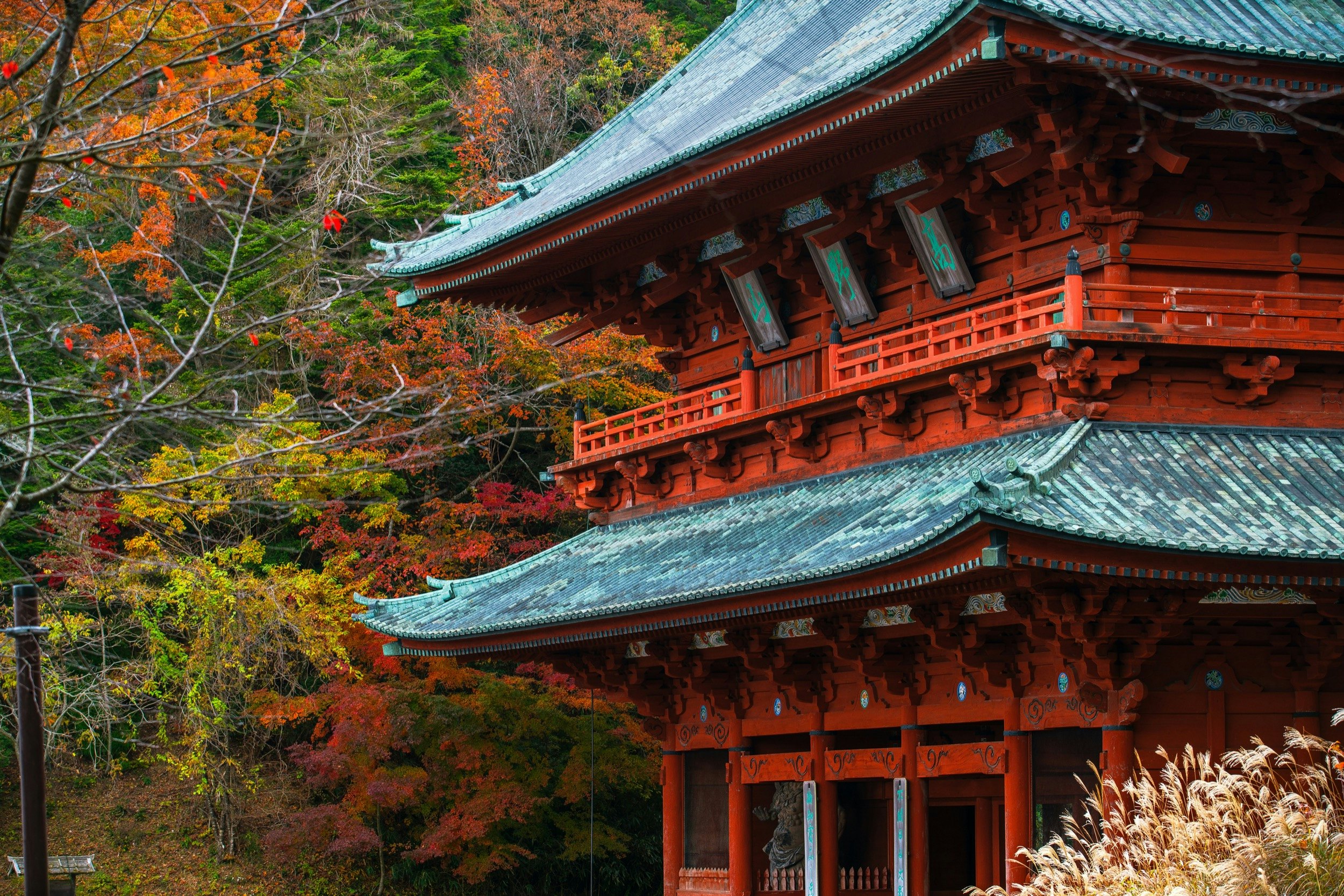
Around 1.2 miles further along the track are two stone torii gates, Futatsu-torii (futatsu means ‘two’ in Japanese), standing in the middle of a charming backdrop of Choishi-Michi. It is said these were built by Kōbō Daishi Kukai for the deities.
Yadate, around 4 miles further, marks two-thirds of the trek. Here, there’s also vending machines for drinks and a teahouse selling yakimochi (grilled rice cakes), a specialty of the region.
The steep last 4 miles rewards hikers with the formal entrance to Koyasan: the towering 25- meter-tall gate, Daimon Gate. Originally built in the 11th century, the three passageways of the gate are flanked by two fierce-looking guardian deities. The location offers sweeping views of the valley, and the glow of the setting sun illuminating the layers of mountaintops makes this one of Japan’s most coveted sunset vistas.
An overnight stay in a shukubo offers an immersive Koyasan experience, and there are around 50 to choose from in the area. Each differs slightly in facilities and format – featuring meditation, sutra teachings, sutra calligraphy practice – but shared is the opportunity for a rare glimpse into monastic life, and enjoy a deeply calm, reflective experience. The simple lodgings feature tatami floors, sliding fusuma doors, and futon beds; meals served are shojin ryori (a colorful spread of vegetarian Buddhist cuisine), with ingredients like goma-tofu (sesame tofu), yuba (tofu skin), and seasonal vegetables. Prices range from ¥9,000 to ¥15,000 ($85-$140 USD) for one night, which includes dinner and breakfast – and most have relaxing public baths. Reservations are required, and some accept credit cards.
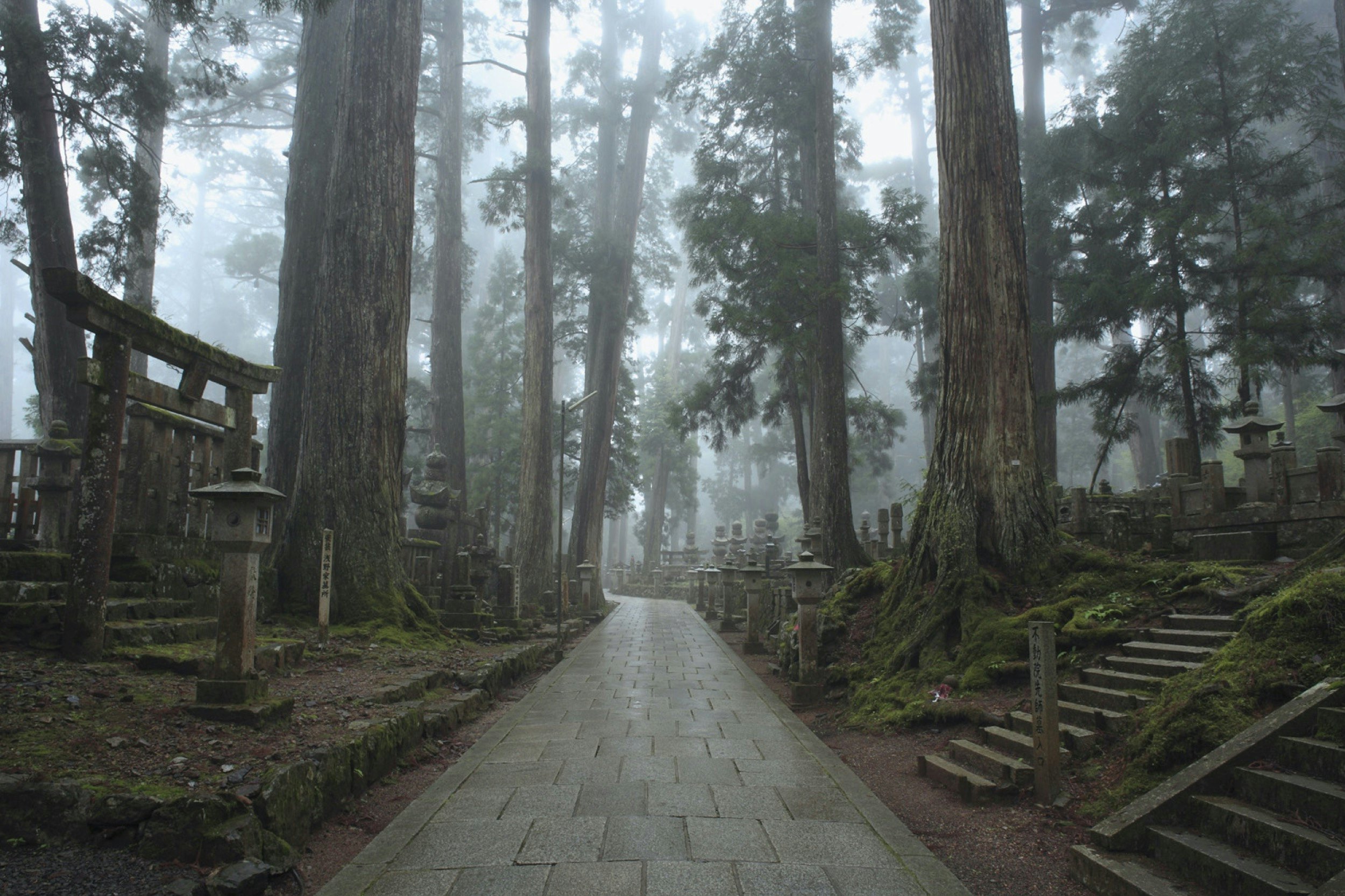
Day 2: Immerse yourself in the tranquility of Koyasan, the spiritual heart of Japan
Rise early for the temple’s morning prayers (usually around 6:00am), where the harmonious, hypnotic chants of the Buddhist monks allow for a spiritual reset. A temple breakfast will follow, another meal of vegetarian temple food, providing nourishment for the next few hours of exploring. There is much to see around Koyasan, but three unmissable attractions are Okuno-in, Danjō Garan Sacred Temple Complex, and Kongobu-ji Head Temple.
Head first to the Okuno-in, a 1.2-mile stretch of graves through the forest from Ichinohashi bridge to the wooden mausoleum where Kōbō Daishi Kukai is praying; according to the Shingon Buddhism sect, he is not dead but in a state of eternal meditation. The path is an ethereal, moving experience through a forest of towering cedar trees – some more than 500 years old – and moss-covered graves, the final resting place for more than 200,000 souls, including some of Japan’s most important historical and religious figures. Dappled light shines through the thick forest canopy, known in Japanese as ‘komorebi’. By the mausoleum, Todoro Hall or ‘Hall of Lanterns’ is filled with hundreds of hanging lanterns and is Okuno-in’s worship hall.

One of the first structures built by Kōbō Daishi Kukai, Danjō Garan Sacred Temple Complex is regarded as the heart of Koyasan. According to legend, when Kōbō Daishi Kukai was studying Buddhism in China, he threw his sankosho (a Buddhist ceremonial tool) back toward Japan. When he was searching for a place to practice asceticism, he discovered his tool in the branches of a pine tree on Koyasan and decided to set up there. Legend has it the pine tree still stands in the Danjō Garan Sacred Temple Complex.
Three impressive features of the temple include the ceremonial hall, Kondō Hall, which enshrines the Buddha of medicine and healing, and the 165-foot-tall, bright vermillion Konpon Daito – both planned by Kōbō Daishi Kukai himself and completed by his nephew Shinzen. The bells within Danjō Garan Sacred Temple Complex ring on the wind, filling the surroundings with a peaceful, reverent atmosphere.
A few minutes’ walk from Danjō Garan, Kongōbu-ji Temple is the administrative Koyasan Shingon Buddhism. Aside from this enormous religious significance, the temple is also known for its mesmerizing Banryutei Rock Garden – the largest in Japan at more than 21,000 sq ft. Visitors can take a self-guided tour through the three main buildings to observe the beautifully painted fusuma (sliding doors), elaborate carved details of woodwork, and traditional furnishings.
To return to Osaka, take the cable car from Koyasan Station to Gokurakubashi station. The journey is an exhilarating five minutes down a scenic hillside slope with spectacular views. From Gokurakubashi station, the Nankai-Limited Express goes directly to Shin-Imamiya station in Osaka, taking around 1.5 hours (¥2,180, about $21 USD).

Day 3: Yoshino
Along with Koyasan, Mount Yoshino in Nara prefecture is one of three sites of the UNESCO listed Sacred Sites and Pilgrimage Routes in the Kii Mountain Range. From Osaka Abenobashi station to Yoshino is just under two hours on the Osaka-Kintetsu line.
Start a day exploring Yoshino with a visit to the majestic Kinpusen-ji Temple, about a 35- minute walk from Yoshino station. Kinpusen-ji Temple is one of the most important temples for Shugendo, an ancient Japanese religion that is a mixture of Shintoism, Buddhism and other ancient Japanese mountain beliefs. The lush mountain scenery, often coated in mist, enhances the atmosphere of sacredness and mystique.
Two main features of Kinpusen-ji Temple are Zao-do Hall and Niomon gate, both connected to the pilgrimage route between Kumano in Wakayama and Mount Yoshino – Zao-do faces south, welcoming pilgrims from Kumano, Niomon faces north, seeing them off to Kumano. Zao-do is a gigantic wooden structure 112 feet high and 118 feet wide, with intricate carvings that add grace to its appearance. It is said that En-no-Gyoja, the founder of Shugendo, was praying for Buddha to appear at Kinpusen-ji Temple when the blue-skinned deity Zao Gongen Statues appeared as an apparition. At certain times of the year, entrance is permitted, and visitors can see the 1,300- year-old, three-bodied statue of Zao Gongen.

Yoshino offers many other intriguing features for exploring – a main street with many shops and cafes and the traditional Japanese garden, Chikurin-in Gunpoen, designed by the famous tea master, Sen-no-Rikyu. If time permits, visit the Hanayagura Observatory at the top of Mount Yoshino, which has breathtaking views, especially in spring and autumn. The mountain is home to more than 30,000 cherry trees, making it one of Japan’s most coveted places for hanami (cherry-blossom viewing).
From Yoshino, return to Osaka on the Kintetsu Minami Osaka Line to Osaka-Abenobashi Station – the last train leaves around 10pm. Alternatively, you could stay in Yoshino at Ryokan Kato and make your way to Murouji Temple in the morning (approximately 2 hours and 15 minutes, fares from ¥1,310, or $12 USD).

Day 4: Murouji Temple and an art forest
Where Koyasan prohibited women from visiting until 1905, Murouji Temple welcomed them, earning its reputation as the ‘Koyasan for women’. To get to Murouji Temple from Tsuruhashi Station in Osaka takes around one hour on the Kintetsu-Osaka Line, followed by a bus from Muroguchiono station for 15 minutes (total cost ¥1,340, about $12.75 USD).
The impressive Murouji Temple complex, established in the 8th century, stands at the foot of Mount Murou, a sacred location since ancient times. Nestled in a mountain valley amidst enormous cedar trees is a 52-foot tall wooden tower – the second-oldest five-storied pagoda in the country. The main hall of Murouji Temple, Kondo Hall, is at the top of Murouji Temple's long stone stairway through the forest, set against a backdrop of vibrant greens and Rhododendron in spring and summer and fiery reds and oranges in autumn.
From Murouji Temple, walk 20 minutes to the Murou Art Forest to wrap an enlightening few days to enrich your soul in another way. This art forest, around half a mile long, was started by local sculptor Inoue Fukichi in 1997 and was completed by renowned Israeli artist Dani Karavan in 2006. The giant modern installations are designed to harmonize with the natural landscape, such as Tower of the Sun, a 26-foot-tall steel sundial. The spacious, serene grounds include plenty of places for birdwatching, picnics, and contemplation.
To return to Osaka, walk back to the Murouji bus stop and take the bus to Murouguchionoeki stop. From Muroguchino station, the Kintetsu-Osaka Line Express to Tsuruhashi Station takes approximately 1 hour (¥900, $8.50 USD). Alternatively, return to Sakurai and spend the next day exploring the ancient town, including a visit to the reverent Ohmiwa Jinja Shrine, one of the oldest in Japan.
Note: There are COVID-19 measures in place across Nara and Wakayama such as ventilation, temperature checks and limits on the number of guests to temples and other sites, as well as hand sanitizer stations and face masks. So when you’re ready to travel again, you can be sure your trip here will be as safe as possible.
You might also like
Keeping ancient traditions alive in Nara and Wakayama Prefectures
Sponsored by Kinki Transportation Bureau
As a travel entertainment and inspirational media outlet, we sometimes incorporate brand sponsors into our efforts. This activity is clearly labeled across our platforms.
This story was crafted collaboratively between Kinki Transportation Bureau and Lonely Planet. Both parties provided research and curated content to produce this story. We disclose when information isn’t ours.
With sponsored content, both Lonely Planet and our brand partners have specific responsibilities:
-
Brand partner
Determines the concept, provides briefing, research material, and may provide feedback.
-
Lonely Planet
We provide expertise, firsthand insights, and verify with third-party sources when needed.







